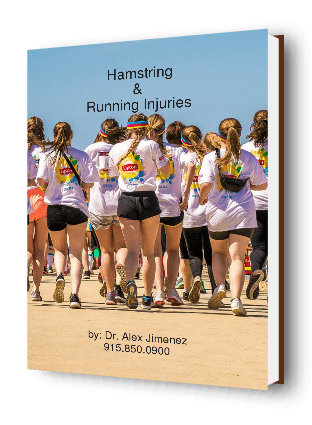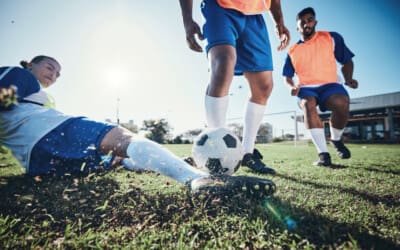Rehabilitating Acute Hamstring Injuries
When returning to the individual’s specific sport, the risk of re-injury is generally higher within the first 2 weeks. This occurs due to initial hamstring weakness, fatigue, lack of flexibility, and strength imbalance between the eccentric hamstrings and the concentric quadriceps. The highest contributing factor though is believed to be linked to an inadequate rehabilitation program, which may correspond with the premature return to physical activity. New evidence has shown the benefits of primarily utilizing eccentric strengthening exercises in hamstring rehabilitation performed with increased loads for longer musculotendinous lengths.
The semitendinosus, or ST, the semimembranosus, or SM, and the biceps femoris long and short heads (BFLH and BFSH) are part of the hamstring muscle group. They primarily function with the extension of the hip and flexion of the knee as well as providing multi-directional stability of the tibia and pelvis. These three muscles which make up the hamstring muscle group, cross the posterior aspect of both the hip and the knee joints, making them bi-articular. As a result, they are consistently responding to large mechanical forces created by upper limb, trunk, and lower limb locomotion as a means of concentric and eccentric mobilization. During sporting activities, these forces will tend to increase, augmenting the frequency of injury.
In a study conducted at the University of Melbourne, biomechanical analysts measured the musculotendinous strain, velocity, force, power, work, and other biomechanical loads experienced by the hamstrings throughout the course of over-ground sprinting and compared the biomechanical load across each individual hamstring muscle.
Basically, the hamstrings are subjected to a stretch-shortening cycle when sprinting, with the lengthening phase occurring during the terminal swing and the shortening phase commencing just before each foot strike, continuing throughout the stance. Then, the biomechanical load on the bi-articular hamstring muscles was determined to be stronger during the terminal swing.
BFLH had the greatest musculotendinous strain, ST displayed considerable musculotendinous lengthening velocity, and SM produced the highest musculotendinous force and both absorbed and generated the most musculotendinous power. Similar research also distinguished peak musculotendinous strain as a large contributor to eccentric muscle damage or injury, most commonly acute hamstring injuries, instead of peak muscle strength. This is why eccentric strengthening is often a rehabilitation recommendation for acute hamstring injuries.
Location and Severity of Injury
In a randomized and controlled study on professional Swedish football players, 69 percent of injuries were primarily located in BFLH. In contrast, 21 percent of the players experienced their primary injury within SM. While the most common, approximately 80 percent, suffered a secondary injury to ST as well as BFLH or SM, a clear 94 percent of the primary injuries were found to be of the sprinting-type and were located in the BFLH, whereas, SM was the most common location for the stretching- type of injury, accounting for approximately 76 percent. These findings were supported in another similar article.
Classifying a soft tissue injury, including acute hamstring injuries, depends largely on a grading system ranging from: I, mild; II, moderate; and III, severe. The different classifications offer useful descriptions for each type of soft tissue injury between healthcare professionals during clinical diagnosis and prognosis following an acute injury. A mild grading describes an injury where a small number of muscle fibers are involved with minor swelling, discomfort, minimal or no loss of strength, or restriction of movement. A moderate grading describes an injury with a significant tear of several muscle fibers, pain and swelling, reduced power, and limited mobility. A severe grading describes an injury where a tear has occurred across an entire cross-section of muscle, commonly a tendinous avulsion, and a surgical opinion may be required. It has also been utilized as a classification system for radiological methods, such as magnetic resonance imaging, or MRI, or ultrasound if required for complementary confirmation of diagnosis.
The British Athletics Medical Team proposed a new injury classification system for improved diagnostic accuracy and prognostication based on MRI features
Determining accurate return-to-play timescales following many acute hamstring injuries has been proven to be difficult. For example, injuries involving an intramuscular tendon or aponeurosis with adjacent muscle fibers generally need shorter recovery periods than those involving a proximal free tendon and/or MTJ.
There’s also been connections between MRI findings according to the region of the injury and return-to-play. Particularly, it has been hypothesized that the shorter the distance between the proximal pole of the injury and the ischial tuberosity found on MRI evaluations similarly determined by the presence of edema, the longer the time to return will be. In the same manner, the length of edema shows a similar effect on recovery time. The longer the length, the longer the recovery. Additionally, the position of peak pain simultaneously following acute hamstring injuries are also associated with increased recovery periods.
Furthermore, there have been attempts to clarify the connection between the grading of acute hamstring injuries and return-to-play. In a prospective cohort study on 207 professional football players with acute hamstring injuries, 57 percent were identified as grade I, 27 percent were identified as grade II, and only 3 percent were identified as grade III. The athletes with grade I injuries returned to play within an average of 17 days. The athletes with grade II injuries returned within 22 days and those with grade III injuries returned approximately within 73 days. According to the study, 84 percent of these injuries affected the BF, 11 percent the SM, and 5 percent the ST. However, there was no significant difference in lay-off time for injuries to the three different muscles. This has been compared to 5-23 days with grade I-II injuries, and 28-51 days for grade I-III in other studies respectively.
Rehabilitation for Acute Hamstring Injuries
Various researchers have previously argued the benefits of eccentric strengthening following acute hamstring injuries against concentric strengthening when focusing to reduce timeframes for return-to-play. The bottom line of this argument is that with the majority of acute hamstring injuries occurring during eccentric loading, the rehabilitation should be similar to the specific circumstance which caused the injury in the first place. One study showed a significant difference between an eccentric and concentric rehabilitation program following acute hamstring injuries in elite and non-elite football players.
The randomized and controlled clinical trial conducted on 75 football players in Sweden, demonstrated that using eccentric strengthening programs rather than concentric strengthening programs, reduced the time to return-to-play by 23 days, regardless of the type of injury or the site of injury. The result showed the number of days to return to full team training and availability for match selection.
Furthermore, two rehabilitation protocols were utilized five days following the injury. All players had sustained a sprinting-type injury as a result of high speed running or a stretching-type injury as a result of high kicking, split positions, and glide tackling. Certain criteria were excluded for the study, including previous acute hamstring injuries, trauma to the posterior thigh, ongoing history of low back complications, and pregnancy.
All players were subjected to an MRI analysis 5 days following the injury, in order to expose the severity and area of injury. A player was considered to be fit enough to return to full-team training using a test known as the active Askling H-test. A positive test is when a player experiences any insecurity or apprehension when performing the test. The test should be completed without full dorsiflexion of the ankle.
Approximately 72 percent of players sustained sprinting-type injuries, while 28 percent experienced stretching-type injuries. Of these, 69 percent suffered an injury to the BFLH, whereas 21 percent were located in the SM. Injuries to ST were only sustained as secondary injuries, approximately 48 percent with the BFLH and 44 percent with the SM. In addition, 94 percent of the sprinting-type injuries were located in the BFLH while the SM was the most common location for the stretching-type injury, accounting for about 76 percent of the injuries.
The two rehabilitation protocols used were labeled the L-protocol and the C-protocol. The L-protocol focused on loading the hamstrings during lengthening and the C-protocol consisted of exercises with no emphasis on lengthening. Each protocol utilized three exercises that could be performed anywhere and were not dependent of advanced equipment. They also aimed at targeting flexibility, mobilization, trunk, and pelvic and/or muscle stability as well as specific strength training to the hamstrings. All were performed in the sagittal plane with speed and load progression.
Conclusion of Study
The time to return was determined to be significantly shorter in the L-protocol as compared to the C-protocol, averaging 28 days and 51 days appropriately. Time to return was also significantly shorter in the L-protocol than in the C-protocol for acute hamstring injuries of both sprinting-type and stretching-type as well as for injuries of different injury classification. However, there still remains a question over whether the C-protocol is specific enough for hamstring activation to create a legitimate comparison.
It’s Easy To Become A Patient!
Just Click The Red Button!
Check Out Our BlogRegarding Sports Injuries
Wrist Protection: How to Prevent Injuries When Lifting Weights
For individuals who lift weights, are there ways to protect the wrists and prevent injuries when lifting weights? Wrist Protection The wrists are complex joints. The wrists significantly contribute to stability and mobility when performing tasks or lifting weights....
Recovering from a Triceps Tear: What to Expect
For athletes and sports enthusiasts, a torn triceps can be a serious injury. Can knowing their symptoms, causes, risk factors, and potential complications help healthcare providers develop an effective treatment plan? Torn Triceps Injury The triceps is the muscle on...
Achilles Tendon Tears: Risk Factors Explained
Individuals who participate in physical and sports activities could suffer an Achilles tendon tear. Can understanding the symptoms and risks help in treatment and return the individual back to their sports activity sooner? Achilles Tendon This is a common injury that...
Professional Scope of Practice *
The information herein on "Sports Injuries" is not intended to replace a one-on-one relationship with a qualified health care professional or licensed physician and is not medical advice. We encourage you to make healthcare decisions based on your research and partnership with a qualified healthcare professional.
Blog Information & Scope Discussions
Our information scope is limited to Chiropractic, musculoskeletal, physical medicines, wellness, contributing etiological viscerosomatic disturbances within clinical presentations, associated somatovisceral reflex clinical dynamics, subluxation complexes, sensitive health issues, and/or functional medicine articles, topics, and discussions.
We provide and present clinical collaboration with specialists from various disciplines. Each specialist is governed by their professional scope of practice and their jurisdiction of licensure. We use functional health & wellness protocols to treat and support care for the injuries or disorders of the musculoskeletal system.
Our videos, posts, topics, subjects, and insights cover clinical matters, issues, and topics that relate to and directly or indirectly support our clinical scope of practice.*
Our office has reasonably attempted to provide supportive citations and has identified the relevant research study or studies supporting our posts. We provide copies of supporting research studies available to regulatory boards and the public upon request.
We understand that we cover matters that require an additional explanation of how it may assist in a particular care plan or treatment protocol; therefore, to further discuss the subject matter above, please feel free to ask Dr. Alex Jimenez, DC, or contact us at 915-850-0900.
We are here to help you and your family.
Blessings
Dr. Alex Jimenez DC, MSACP, RN*, CCST, IFMCP*, CIFM*, ATN*
email: coach@elpasofunctionalmedicine.com
Licensed as a Doctor of Chiropractic (DC) in Texas & New Mexico*
Texas DC License # TX5807, New Mexico DC License # NM-DC2182
Licensed as a Registered Nurse (RN*) in Florida
Florida License RN License # RN9617241 (Control No. 3558029)
Compact Status: Multi-State License: Authorized to Practice in 40 States*
Dr. Alex Jimenez DC, MSACP, RN* CIFM*, IFMCP*, ATN*, CCST
My Digital Business Card






